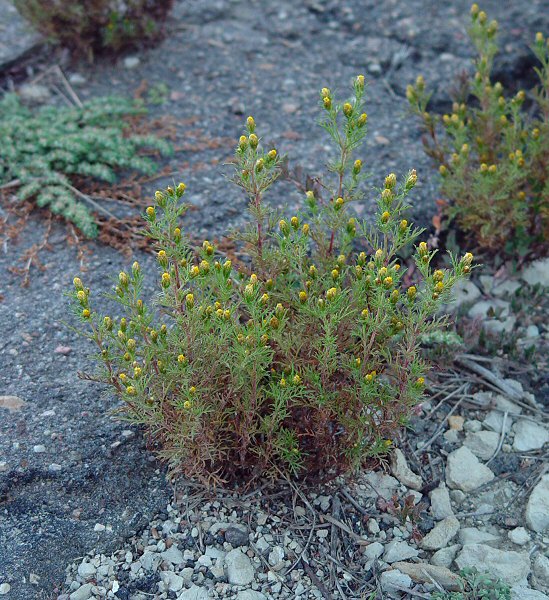Dyssodia papposa (Vent.) Hitchc.
Fetid Marigold

Native
CC = 1
CW = 5
MOC = 43
© DETenaglia
Dyssodia papposa (Vent.) Hitchc.Fetid Marigold | |
 |
Native CC = 1 CW = 5 MOC = 43 |
© DETenaglia |
|
Family - Asteraceae/Heliantheae Stems - Annual from a big taproot, multiple from the base, erect to ascending, herbaceous, appressed pubescent, green to reddish with vertical colored lines, much-branched, to 30cm tall (long).
Leaves - Opposite, sessile, distichous, to +/-3.5cm long, +/-1.5cm broad, deeply pinnatifid, glabrous, with scattered tannish-red glands. Divisions of the leaves linear, with a few coarse serrate teeth on the margins, often slightly folded (conduplicate) in strong sun.
Inflorescence - Short-pedunculate flower heads from the leaf axils. The peduncles with reduced leaves at the base, 3-8mm long, appressed pubescent, expanded towards the apex.
Involucre - Biseriate, 7-10mm long, 5-7mm broad. Outer series loose, of linear phyllaries. The phyllaries spreading at the apex, glabrous but with ciliolate margins (at least in the middle or basal half), +/-7mm long, 1.5mm broad at the base, with scattered glands. Phyllaries of the inner series larger than those of the outer, +/-8mm long, 2-3mm broad, glabrous, with many glands, sub-acute at the apex, oblong-linear.
Ray flowers - Flowers pistillate and fertile, +/-8 per head. Ligule short, 1mm long, -1mm broad, notched at the apex, glabrous. Corolla tube +/-3mm long, with antrorse pubescence, white in the basal 2/3, yellow above. Style translucent below, glabrous, bifurcate at the apex. Stigmas yellow, .6-.8mm long, recurved, glabrous. Pappus of multiple +/-10 laciniate awns. Awns 2-2.8mm long, purplish at the tips, whitish below. Achenes black, +/-3mm long, -1mm broad, sparse sericeous to glabrous. Disk flowers - Flowers +/-20 per head, fertile. Corolla tube +3mm long, pubescent as the ray flowers, colored as the ray flowers, 5-lobed. Lobes small, .3mm long, .2mm broad, erect to slightly spreading, glabrous, acute. Stamens 5, included, adnate near the base of the corolla tube. Filaments greenish-translucent, 1-1.5mm long. Anthers yellow, connate around the style, 1-1.3mm long. Style included, +/-2mm long, glabrous, greenish-translucent in the basal 2/3, yellowish above. Stigma bifurcate, barely exserted beyond the anthers, included in the corolla tube, yellowish-purple at the apex. Stigmas .5-.6mm long, erect to slightly spreading. Pappus and achenes as with the ray flowers. Receptacle flattish, with no large chaff.
Flowering - May - October. Habitat - Dry fields, pastures, loess hills, prairies, waste ground, roadsides, railroads. Origin - Native to U.S. Other info. - This little species can be found scattered throughout Missouri but is most common in the northern portion of the state. The plant is easy to identify becasue of its small size, opposite, divided leaves, and incredible aroma. The glands of the plant are filled with a watery liquid that has a distinctive smell and is unmistakable. Photographs taken at Tall Grass Prairie National Preserve, KS., 9-19-06. |